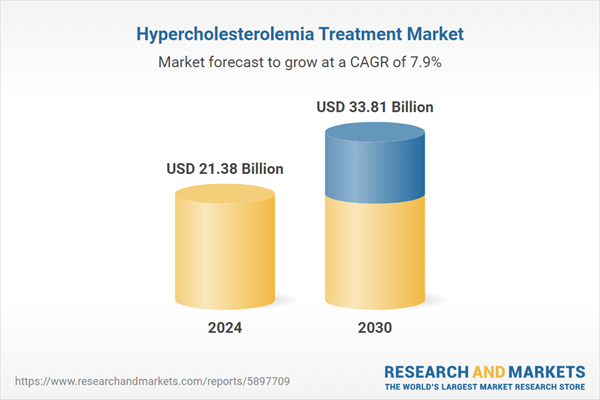Speak directly to the analyst to clarify any post sales queries you may have.
10% Free customizationThis report comes with 10% free customization, enabling you to add data that meets your specific business needs.
Unhealthy dietary habits, sedentary lifestyles, and genetic predispositions are among the key factors contributing to the growing incidence of hypercholesterolemia. These conditions are fueling demand for effective treatment solutions. Increased public awareness regarding the health risks associated with elevated LDL (low-density lipoprotein) cholesterol - such as heart attacks, strokes, and peripheral arterial disease - has underscored the importance of early diagnosis and prompt therapeutic intervention.
Furthermore, robust support from both public and private sector healthcare initiatives has led to expanded screening programs and greater advocacy for routine cholesterol testing. These programs are encouraging individuals to proactively seek medical guidance and appropriate treatment options.
Market Drivers
Rising Prevalence of Hypercholesterolemia
The global rise in hypercholesterolemia cases is strongly linked to evolving lifestyle and dietary trends. Sedentary routines combined with high intake of saturated fats and processed foods have significantly increased the number of individuals with high cholesterol levels. According to the World Health Organization (WHO), in 2008, the global prevalence of raised total cholesterol among adults stood at 39% (37% among males and 40% among females), highlighting the widespread nature of this health issue.Additionally, the global population is aging at a rapid pace. The United Nations Department of Economic and Social Affairs projects that the population aged 65 and older will reach 1.5 billion by 2050, up from 703 million in 2019. Aging is associated with a decline in the body’s efficiency in metabolizing and regulating cholesterol, thereby increasing vulnerability to hypercholesterolemia.
Market Challenges
High Cost of Treatment
One of the most pressing challenges in the hypercholesterolemia treatment market is the high cost of therapies, which can hinder access to care and negatively impact patient outcomes. As a chronic condition, hypercholesterolemia typically requires long-term treatment, adding to the financial burden on both patients and healthcare systems.Although several treatment options are available - including statins and newer agents such as PCSK9 inhibitors - their cost can be prohibitively high, especially for patients without comprehensive insurance coverage. This often leads to delayed treatment initiation, suboptimal adherence, and increased risk of cardiovascular complications.
The economic burden is further compounded by healthcare disparities, particularly among low-income populations who may struggle to afford necessary medications and follow-up care. Consequently, these financial obstacles contribute to unequal access to care and exacerbate existing public health challenges.
Healthcare systems and insurers also face strain from the high cost of providing widespread access to advanced cholesterol-lowering therapies. This pressure may result in limitations on coverage, reduced treatment availability, and compromised quality of care.
Market Trends
Advancements in Pharmaceutical Research
Innovations in pharmaceutical research are significantly advancing the global hypercholesterolemia treatment landscape. While statins have long served as the standard of care, recent developments have introduced novel therapeutic options that are reshaping the market.Among the most notable innovations is the emergence of PCSK9 inhibitors, which provide an alternative mechanism for lowering LDL cholesterol, particularly in patients who do not respond adequately to statin therapy. These biologics target a specific protein involved in cholesterol regulation, offering enhanced efficacy for certain patient groups.
Ongoing research is also yielding drugs with improved safety profiles and fewer side effects, addressing concerns associated with traditional therapies such as muscle pain. These developments have led to a broader range of treatment options, improving patient compliance and clinical outcomes.
Key Market Players
- Amgen Inc
- Amryt Pharma plc
- AstraZeneca Plc.
- Regeneron Pharmaceuticals, Inc.
- Novartis Pharmaceuticals Corporation
- Teva Pharmaceutical Industries Ltd.
- Cipher Pharmaceuticals Inc.
- Pfizer Inc.
- Merck & Co., Inc.
- Sun Pharmaceutical Industries Limited
Report Scope:
In this report, the Global Hypercholesterolemia Treatment Market has been segmented into the following categories, in addition to the industry trends which have also been detailed below:Hypercholesterolemia Treatment Market, By Disease Type:
- Genetic Hypercholesterolemia
- Acquired Hypercholesterolemia
Hypercholesterolemia Treatment Market, By Treatment Type:
- Statins
- PCSK9 Inhibitors
- Ezetimibe
- Bile Acid Sequestrants
- Niacin
- Bempedoic Acid
- Others
Hypercholesterolemia Treatment Market, By End User:
- Hospitals & Clinics
- Ambulatory Care Centres
- Others
Hypercholesterolemia Treatment Market, By Region:
- North America
- United States
- Canada
- Mexico
- Europe
- France
- United Kingdom
- Italy
- Germany
- Spain
- Asia-Pacific
- China
- India
- Japan
- Australia
- South Korea
- South America
- Brazil
- Argentina
- Colombia
- Middle East & Africa
- South Africa
- Saudi Arabia
- UAE
Competitive Landscape
Company Profiles: Detailed analysis of the major companies present in the Global Hypercholesterolemia Treatment Market.Available Customizations:
With the given market data, the publisher offers customizations according to a company's specific needs. The following customization options are available for the report.Company Information
- Detailed analysis and profiling of additional market players (up to five).
This product will be delivered within 1-3 business days.
Table of Contents
Companies Mentioned
- Amgen Inc
- Amryt Pharma plc
- AstraZeneca Plc.
- Regeneron Pharmaceuticals, Inc.
- Novartis Pharmaceuticals Corporation
- Teva Pharmaceutical Industries Ltd.
- Cipher Pharmaceuticals Inc.
- Pfizer Inc.
- Merck & Co., Inc.
- Sun Pharmaceutical Industries Limited
Table Information
| Report Attribute | Details |
|---|---|
| No. of Pages | 186 |
| Published | April 2025 |
| Forecast Period | 2024 - 2030 |
| Estimated Market Value ( USD | $ 21.38 Billion |
| Forecasted Market Value ( USD | $ 33.81 Billion |
| Compound Annual Growth Rate | 7.9% |
| Regions Covered | Global |
| No. of Companies Mentioned | 10 |









